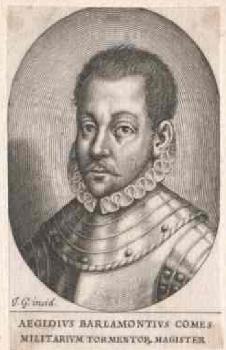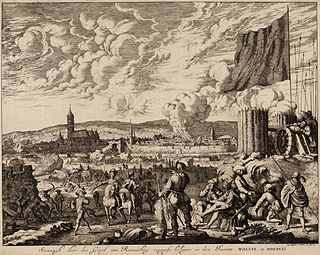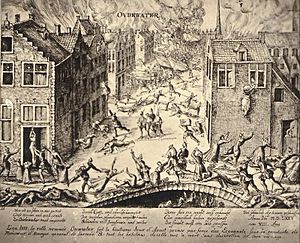
Oudewater is a municipality and a city in the Netherlands.

Naarden is a city and former municipality in the Gooi region in the province of North Holland, Netherlands. It has been part of the new municipality of Gooise Meren since 2016.

The Eighty Years' War or Dutch Revolt was an armed conflict in the Habsburg Netherlands between disparate groups of rebels and the Spanish government. The causes of the war included the Reformation, centralisation, excessive taxation, and the rights and privileges of the Dutch nobility and cities.

The siege of Haarlem was an episode of the Eighty Years' War. From 11 December 1572 to 13 July 1573 an army of Philip II of Spain laid bloody siege to the city of Haarlem in the Netherlands, whose loyalties had begun wavering during the previous summer. After the naval battle of Haarlemmermeer and the defeat of a land relief force, the starving city surrendered and the garrison was massacred. The resistance nonetheless was taken as an heroic example by the Orangists at the sieges of Alkmaar and Leiden.

The siege of Leiden occurred during the Eighty Years' War in 1573 and 1574, when the Spanish under Francisco de Valdez attempted to capture the rebellious city of Leiden, South Holland, the Netherlands. The siege failed when the city was successfully relieved in October 1574.

The Spanish Fury was a number of violent sackings of cities (lootings) in the Low Countries or Benelux, mostly by Spanish Habsburg armies, that happened in the years 1572–1579 during the Dutch Revolt. In some cases, the sack did not follow the taking of a city. In others, the sack was ordered, or at least not restrained, by Spanish commanders after the fall of a city.

Rudolph Snel van Royen, Latinized as Rudolphus Snellius, was a Dutch linguist and mathematician who held appointments at the University of Marburg and the University of Leiden. Snellius was an influence on some of the leading political and intellectual forces of the Dutch Golden Age.

Frederik Schenck van Toutenburg was the first Archbishop of Utrecht (1559–1580). Prior to Schenck's ministry as archbishop, Utrecht was a bishopric with a succession of sixty bishops. The last bishop of Utrecht, prior to Schenck was George van Egmond. After Schenck's death in 1580, the see would remain vacant until Sasbold Vosmeer assumed the archbishopric in 1602.

The Army of Flanders was a multinational army in the service of the kings of Spain that was based in the Spanish Netherlands during the 16th to 18th centuries. It was notable for being the longest-serving army of the period, being in continuous service from 1567 until its disestablishment in 1706 and taking part in numerous pivotal battles of the Dutch Revolt (1566–1609) and the Thirty Years' War (1618–1648). Because it employed or pioneered many developing military concepts more reminiscent of later military units, enjoying permanent, standing regiments (tercios), barracks, military hospitals and rest homes long before they were adopted in most of Europe, the Army of Flanders has been considered the world's de facto first modern professional standing army. Sustained at huge cost and at significant distances from Spain via the Spanish Road, the Army of Flanders also became infamous for successive mutinies and its ill-disciplined activity on and off the battlefield, including the Sack of Antwerp in 1576.

Gilles van Berlaymont was stadtholder for the Spanish Crown of Drenthe, Friesland, Groningen and Overijssel (1572-1573), stadtholder of Guelders (1572–1577), substitute stadtholder of Holland, Zeeland and Utrecht (1574–1577), stadtholder of Namur and Artois and baron of Hierges.

The siege of Mons of 1572 took place at Mons, capital of the County of Hainaut, Spanish Netherlands, between 23 June and 19 September 1572, as part of the Eighty Years' War, the Anglo-Spanish War (1585–1604), and the French Wars of Religion. In the spring of 1572, after the capture of Valenciennes by a Protestant force under Louis of Nassau, the Dutch commander continued with his offensive and took Mons by surprise on 24 May. After three months of siege, and the defeats of the armies of Jean de Hangest, seigneur d'Yvoy and Genlis, and William the Silent, Prince of Orange (Dutch: Willem van Oranje), by the Spanish army led by Don Fernando Álvarez de Toledo, Duke of Alba, Governor-General of the Spanish Netherlands, and his son, Don Fadrique de Toledo, Louis of Nassau's forces, isolated and without any hope of help, surrendered Mons to the Duke of Alba on 19 September.
The siege of Schoonhoven of 1575, also known as the capture of Schoonhoven, was a Spanish victory that took place between 11 and 24 August 1575, at Schoonhoven, Spanish Netherlands, during the Eighty Years' War and the Anglo-Spanish War (1585–1604). On June 28, 1575, the Spanish forces, between 8,000 and 10,000 soldiers, led by Gilles de Berlaymont, Lord of Hierges, and Stadtholder of Guelders, Holland, Zeeland and Utrecht, captured Buren, and on August 7, Oudewater. The Spanish commander continued its successful progress and arrived at Schoonhoven on August 11. After 13 days of siege, and a courageous but futile resistance, the rebel forces led by De La Garde, composed by Dutch, English, Scottish, French and Walloon soldiers, surrendered to the more experienced Spanish troops, on August 24. The population of the town, that were unwilling to help the rebel forces, received Berlaymont with great joy.

The siege of Eindhoven, also known as the capture of Eindhoven of 1583, took place between 7 February and 23 April 1583 at Eindhoven, Duchy of Brabant, Spanish Netherlands during the Eighty Years' War and the Anglo-Spanish War (1585–1604). On 7 February 1583 a Spanish force sent by Don Alexander Farnese, Governor-General of the Spanish Netherlands, commanded by Karl von Mansfeld and Claude de Berlaymont, laid siege to Eindhoven, an important and strategic city of Brabant held by Dutch, Scottish, and French soldiers under the States' commander Hendrik van Bonnivet. After three months of siege, and the failed attempts by the States-General to assist Bonnivet's forces, the defenders surrendered to the Spaniards on 23 April.

The siege of Steenwijk took place from October 18, 1580 – February 23, 1581 during the Eighty Years' War and the Anglo–Spanish War, between a besieging Spanish force under turncoat George van Lalaing against a Dutch rebel garrison at Steenwijk under Johan van den Kornput. An English and Dutch rebel force under John Norreys successfully relieved the town on January 24, and the Spanish in addition to ill-health and lack of supplies subsequently lifted the siege in February.

The siege of Zutphen was an eleven-day siege of the city of Zutphen by Dutch and English troops led by Maurice of Nassau, during the Eighty Years' War and the Anglo–Spanish War. The siege began on 19 May 1591 after a clever ruse by the besiegers. The city was then besieged for eleven days, after which the Spanish garrison surrendered.

The siege of Middelburg (1572–1574) lasted over a year during the Eighty Years' War. A Dutch rebel army with the support of the English laid siege to Middelburg, which was being held by Spanish forces under Cristóbal de Mondragón, on 4 November 1572. The Spanish held out and only capitulated on 18 February 1574, when news arrived that a relief effort to save Middelburg was defeated at Rimmerswiel.
The Capture of Valkenburg of 1574, took place in early February 1574, at Valkenburg, South Holland, during the Eighty Years' War and the Anglo-Spanish War (1585–1604), in the context of the siege of Leiden. The fortress of Valkenburg, garrisoned by five English companies commanded by Colonel Edward Chester, was of strategic importance to facilitate the Spanish efforts at Leiden. In early February, when the Spanish troops advanced over Valkenburg Castle, the English troops surrendered the fortress to the Spaniards and fled towards Leiden. Then, the Spanish forces entered and took possession of the fortress. For the cowardice demonstrated at Valkenburg, the English troops were rejected by the Dutch rebel army at Leiden, and finally Chester's troops surrendered to the Spanish army.

The Battle of Delft, also known as the Defence of Delft, was a military engagement fought during the Eighty Years' War and the Anglo–Spanish War which took place in October 1573 in and outside the city of Delft. The battle was fought by a small Anglo-Dutch force under Thomas Morgan and an attacking Spanish force under Francisco de Valdez. The Spanish were repelled and forced to retreat.

The period between the Capture of Brielle and the Pacification of Ghent was an early stage of the Eighty Years' War between the Spanish Empire and groups of rebels in the Habsburg Netherlands.

















